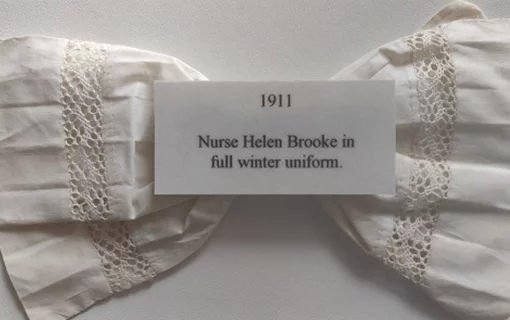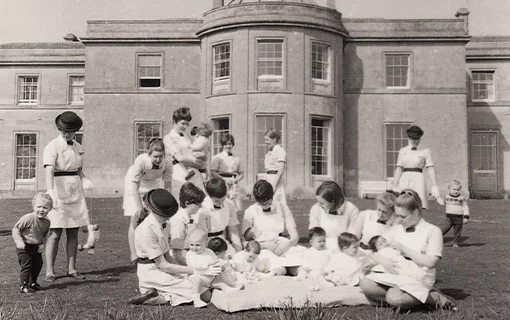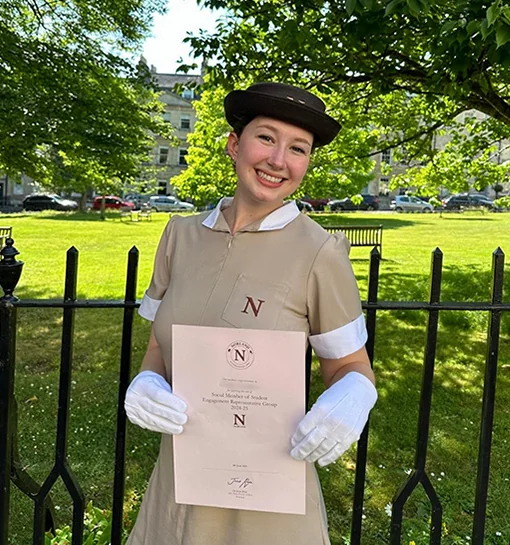The history of Norland in 13 objects: the Norland uniform
25 September 2022

The fifth object in our series celebrating Norland’s 130-year history is one of the earliest items of Norland uniform in our archives. The iconic uniform has been an essential part of Norland since its inception in 1892 and remains a strong part of its heritage. Early uniform items are rare. In this blog, we look at some of the oldest items of uniform in our collection.
Founded in Norland Place, London by education pioneer Emily Ward, the Norland Institute (as it was then known) was the first establishment to provide education and training in the care of babies and young children. In doing so, Emily Ward created a brand-new profession, the trained nursery nurse, and laid the foundations on which all future nursery training would be based.
The Norland uniform was instituted by Emily Ward to ensure Norland nurses were instantly recognisable and distinct from other members of the household. The uniform was a key aspect of professionalising those taking on a role that was often undervalued and easily dismissed.

The earliest uniform item in the archives that can be accurately dated is a bow from 1911 that belonged to Nurse Helen Brooke. Nurse Brooke trained at Norland between 1911 and 1912 and enjoyed a long career, including 28 years as Health Visitor in the Child Welfare Department at London’s University College Hospital until her retirement in 1947.
In recognition of her career longevity, Nurse Brooke received a long-service badge for service between 1913 until 1924, followed by the silver bar for 10 years of service and the blue bar for 15 years. In 1943, she was presented with the highest accolade, the Norland green bar for 21 years of service, by Her Royal Highness the Duchess of Kent at a formal badge ceremony held at the Institute’s new wartime headquarters at Chislehurst.
Other early items in the archives include brown bonnets from the first years of the Institute, and a blue silk dress and long brown cotton coat that date to approximately the 1920s-30s.

The uniform worn by the first probationers when Norland opened its doors on 25 September 1892, comprised a morning or ‘heavy work’ pink and white-striped Galatea dress with apron and detachable collar and cuffs, alternated with a smarter blue beige silk dress for afternoons and formal occasions. A black or light grey bonnet and cloak, depending on the season, a white cambric tie for indoors or a red tie for the Galatea dress and white woollen or cotton gloves. Sleeves were full, in the Edwardian ‘leg o’ mutton’ style, and skirts were ankle-length topped by an immaculate white linen apron of almost the same length.
The first uniforms were supplied by Debenham and Freebody in Kensington. In 1895, Emily Ward opened workrooms in the Institute to provide work for gentlewomen in need of an income. These inhouse facilities enabled changes to be more easily made to the uniform in keeping with fashion and practicality. Later suppliers included the specialist nurse uniform and medical suppliers Garrould’s of Edgware Road, and Harrods.

Much like the curriculum, the Norland uniform has evolved over the years. By the turn of the century, the light grey summer cloak and bonnet were found to fade too easily and were replaced with brown. The original winged black cloak was modified to a two-piece construction better suited to carrying babies. A simple white or brown hat was introduced for wearing in the summer in the country or at the seaside. The silk dress was replaced with a light blue serge (wool) and a fawn-coloured drill cotton dress with coloured tie was introduced for summer wear. In 1919, a little later than originally planned due to the scarcity of wool during the war, the cloak was replaced with a more practical long coat.
The pink and white-striped Galatea dress, which was also worn during the hospital training term, was changed to blue to avoid confusion with ward maids who also wore pink. Historian Penelope Stokes, in her book Norland: The Story of the First One Hundred Years, noted “there was a tradition of calling the Norlander ‘Pinkie’ in hospital” for “many years, even until the First World War”.

In keeping with the behaviour and professional standards required of Norlanders as role-models for children and professionals, there were strict rules about dress. Nurses were not allowed to individualise their appearance with non-regulation items nor to wear anything impractical that might endanger the safety of a child, such as high heels or jewellery. Bobbed hair was forbidden. Barbara Stokes notes that, while Emily Ward admitted in the March 1925 Quarterly to personally liking the modern shingle haircut and finding it practical, her priority was to anticipate the opinions of employers. Therefore, “Norlanders had to be content with a place in the wake rather than the vanguard of fashion”.
With the establishment of several competitor institutions in the early 20th century came the threat of imposter Norlanders. Modelling their uniforms on the Norland style, these copycat nurses posed a very real threat to the reputation of the Institute and its graduates. It became necessary to ensure that any surplus items were returned to Norland and to make private sales a disciplinary offence.
After a few years, the need arose to adapt the uniform so that it was possible to distinguish fully qualified nurses from probationers and newly qualified nurses. In 1902, the speedwell badge was inaugurated as an award for nurses with at least five years of employment since qualifying including in one role for at least three years. In 1916, am optional silver N.I. monogram was introduced for nurses to wear on gaining their qualification. Like the long-service badge, it was a flat design to protect children. It also featured holes enabling it to be sewn on to the cloak without the need for a pin.

In the 1928 prospectus, the uniform was given as a brown hat and cloak, blue dress, holland cotton dress for summer or morning wear, white apron, white cambric tie, white starched collar, brown bow, and belt. Optional uniform included a brown mackintosh, storm cap and jersey, and a Panama hat with the initials NI on the band. In the early 1930s, under the leadership of Principal Miss Winterbotham, the starchy white collars and cuffs were replaced with softer material and the stiff white belt was abolished.
In a 1935 pre-arrival letter to a probationer, Miss Winterbotham provided a brown swatch of coat material to assist with the purchase of matching brown shoes and winter stockings, which could only be obtained from and mended by Garrould’s. Light brown stockings were deemed more appropriate for the summer. Matching brown cardigans could be purchased from the workrooms. Natural shantung or tussore silk underskirts were recommended for wearing under the holland dress. In 1938, a new uniform option of skirt, silk blouse and coat was introduced for nurses with at least three years of employment experience after qualification.

During World War II, it was impossible to secure the materials for the uniform and so nurses made do with their older uniforms. Cloaks and other redundant uniform items were recycled to make student uniforms. In the later years of the war, students wore their own clothes with green overalls. The formal uniform changed from its traditional blue to the current beige due to the need for dye for the war effort and its continued scarcity in the ensuing years.
By the 1950s, the NI monogram had been replaced by the N we know today. Principal Lucy Keymer modified the uniform with the introduction in the late 1960s of the now iconic bowler hat to replace the pre-war hat, and a more modern poplin raincoat to replace the brown nylon mac.

For several decades, Norlanders have not been required to wear the world-famous uniform outside of training. Today’s students still wear a formal and a practical uniform at college while studying for the prestigious Norland degree and diploma, as their predecessors did 130 years ago. Graduates wear their own clothes in employment, including during the paid probationary Newly Qualified Nanny year that is the final module of the diploma. Fully qualified Norlanders are still awarded a silver speedwell badge, introduced in 1959, on accession to the coveted title.
The most recent uniform redesign took place in 2013. The dress was updated to give a more contemporary look and practical fit, and a bespoke Norland tweed coat was introduced. When the first men to study for the degree and diploma entered Norland in 2015, a new formal uniform comprising beige trousers and tweed blazer was introduced.

In 2021, Norland launched a gender-neutral option, enabling students to choose to wear formal trousers or a dress with the bespoke Norland tweed blazer.
The Norland uniform continues to evolve while at the same time paying homage to the pioneering history and profession it represents. Every year, a new cohort of students (known as a set) enrols at Norland, proudly wearing the uniform and adhering to the rules that accompany it, as they train to become world-famous Norland Nannies.








